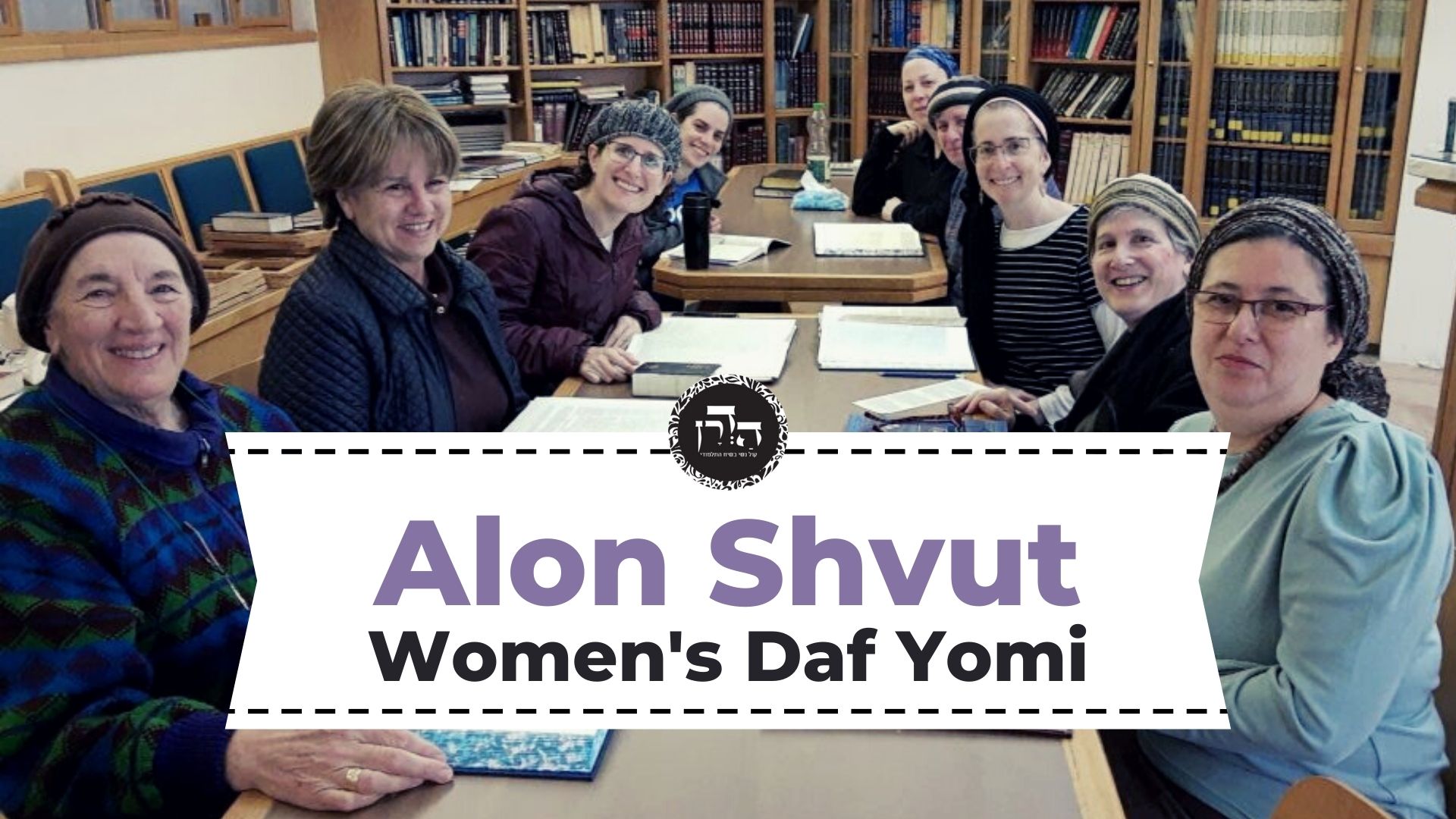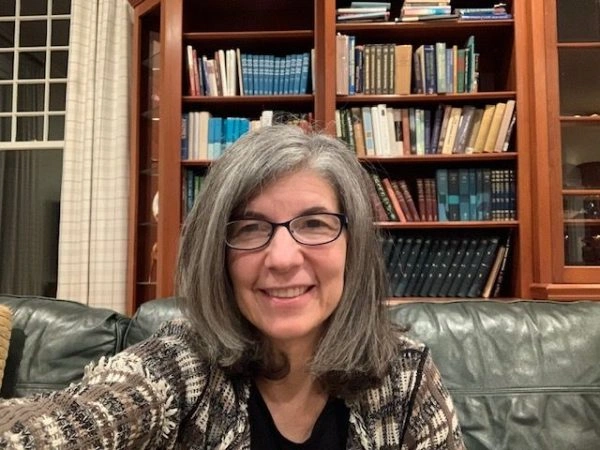This is the daf for Tisha B’av. For Shabbat’s daf, click here.
Sukkah 11
Share this shiur:
This week’s learning is sponsored by Robert and Paula Cohen in loving memory of Joseph Cohen, Yosef ben Moshe HaCohen, z”l. “He was hard working, loved to sing, esp. as a chazan, and was very dedicated to his family and community.”
Want to dedicate learning? Get started here:


Today’s daily daf tools:
This week’s learning is sponsored by Robert and Paula Cohen in loving memory of Joseph Cohen, Yosef ben Moshe HaCohen, z”l. “He was hard working, loved to sing, esp. as a chazan, and was very dedicated to his family and community.”
Today’s daily daf tools:
Delve Deeper
Broaden your understanding of the topics on this daf with classes and podcasts from top women Talmud scholars.
New to Talmud?
Check out our resources designed to help you navigate a page of Talmud – and study at the pace, level and style that fits you.
The Hadran Women’s Tapestry
Meet the diverse women learning Gemara at Hadran and hear their stories.
Sukkah 11
וּבַיִת נָמֵי, אַף עַל פִּי שֶׁאֵין גָּבוֹהַּ עֲשָׂרָה, כֵּיוָן דִּקְבִיעַ — אוּהְלָא הוּא, דְּלָא גָּרַע מִקִּינוֹפוֹת.
And this halakha that it is not sufficient to place his head out the window applies also to a house even if it is not ten handbreadths high. Since it is a fixed structure it is considered a tent in and of itself, as it is no less permanent than a bed with four posts, which is considered a tent even though the netting is less than ten handbreadths higher than the bed.
לִישָּׁנָא אַחֲרִינָא אָמְרִי לַהּ, אָמַר רַב יְהוּדָה אָמַר שְׁמוּאֵל: מוּתָּר לִישַׁן בְּכִילַּת חֲתָנִים בַּסּוּכָּה לְפִי שֶׁאֵין לָהּ גַּג, אַף עַל פִּי שֶׁגְּבוֹהָה עֲשָׂרָה.
Some say another version of the previous discussion: Rav Yehuda said that Shmuel said: It is permitted to sleep inside a netted bridal canopy in the sukka since it is inclined and does not have a roof, even though it is ten handbreadths high.
מֵיתִיבִי: הַיָּשֵׁן בְּכִילָּה בַּסּוּכָּה — לֹא יָצָא יְדֵי חוֹבָתוֹ! הָכָא בְּמַאי עָסְקִינַן — בְּשֶׁיֵּשׁ לָהּ גַּג.
The Gemara raises an objection from a baraita: One who sleeps in a bed with netting inside the sukka did not fulfill his obligation. The Gemara answers: With what are we dealing here in the baraita? It is with a bed with netting in a case where, unlike a bridal canopy, it has a roof.
תָּא שְׁמַע: נַקְלִיטִין שְׁנַיִם, וְקִינוֹפוֹת אַרְבָּעָה, פֵּירַס עַל גַּבֵּי קִינוֹפוֹת — פְּסוּלָה, עַל גַּבֵּי נַקְלִיטִין — כְּשֵׁרָה, וּבִלְבַד שֶׁלֹּא יְהוּ נַקְלִיטִין גְּבוֹהִין מִן הַמִּטָּה עֲשָׂרָה טְפָחִים. הָא גְּבוֹהִין מִן הַמִּטָּה עֲשָׂרָה — פְּסוּלָה, אַף עַל פִּי שֶׁאֵין לָהּ גַּג!
Come and hear another question from what we learned: Naklitin are two posts and kinofot are four posts. If one spread a sheet over four posts, the sukka is unfit; if he spread a sheet over two posts the sukka is fit, provided the two posts are not ten handbreadths higher than the bed. It can be inferred from here: But if they are higher than ten handbreadths the sukka is unfit even though it has no roof, contrary to the opinion of Shmuel.
שָׁאנֵי נַקְלִיטִין, דִּקְבִיעִי. אִי קְבִיעִי, לֶיהֱוֵי כְּקִינוֹפוֹת! לְגַבַּי קִינוֹפוֹת — לָא קְבִיעִי, לְגַבֵּי כִילָּה — קְבִיעִי.
The Gemara answers: Two posts are different from the bridal canopy because they are fixed in the bed, and therefore the sheet over them is considered a tent even with an inclined roof. The Gemara asks: If they are fixed then let them be considered like four posts and let them render the sukka unfit even when they are less than ten handbreadths high. The Gemara answers: Vis-à-vis four posts, two posts are not considered fixed and therefore, they render the sukka unfit only when they are ten handbreadths higher than the bed. However, vis-à-vis a bed with netting, two posts are considered fixed and consequently, they render the sukka unfit even though they lack a roof.
דָּרֵשׁ רַבָּה בַּר רַב הוּנָא: מוּתָּר לִישַׁן בְּכִילָּה, אַף עַל פִּי שֶׁיֵּשׁ לָהּ גַּג, אַף עַל פִּי שֶׁגְּבוֹהָה עֲשָׂרָה. כְּמַאן — כְּרַבִּי יְהוּדָה, דְּאָמַר: לָא אָתֵי אֹהֶל עֲרַאי וּמְבַטֵּל אֹהֶל קֶבַע. דִּתְנַן, אָמַר רַבִּי יְהוּדָה: נוֹהֲגִין הָיִינוּ לִישַׁן תַּחַת הַמִּטָּה בִּפְנֵי הַזְּקֵנִים.
Rabba bar Rav Huna taught: It is permitted to sleep in a bed with netting even though it has a roof and even though it is higher than ten handbreadths. In accordance with whose opinion did Rabba bar Rav Huna teach this halakha? It is in accordance with the opinion of Rabbi Yehuda who said that in principle, a temporary tent does not come and negate a permanent tent, as we learned in a mishna that Rabbi Yehuda said: We were accustomed to sleep beneath the bed before the Elders. Since a bed is a temporary tent relative to the more permanent sukka, even one sleeping beneath a bed is considered to be sleeping in the sukka and he fulfills his obligation in that manner.
וְלֵימָא הֲלָכָה כְּרַבִּי יְהוּדָה!
The Gemara asks: And if the statement of Rabba bar Rav Huna is in accordance with the opinion of Rabbi Yehuda, let him say simply that the halakha is in accordance with the opinion of Rabbi Yehuda.
אִי אָמַר הֲלָכָה כְּרַבִּי יְהוּדָה, הֲוָה אָמֵינָא: הָנֵי מִילֵּי מִטָּה, דִּלְגַבָּהּ עֲשׂוּיָה, אֲבָל כִּילָּה, דִּלְתוֹכָהּ עֲשׂוּיָה — אֵימָא לָא, קָא מַשְׁמַע לַן טַעְמָא דְּרַבִּי יְהוּדָה דְּלָא אָתֵי אֹהֶל עֲרַאי וּמְבַטֵּל אֹהֶל קָבַע, לָא שְׁנָא מִטָּה וְלָא שְׁנָא כִּילָּה.
The Gemara answers: If he said the halakha is in accordance with the opinion of Rabbi Yehuda, I would have said that this applies only to a bed, which is made for use atop it and not beneath it. Perhaps the reason a bed is not considered a tent in and of itself is that its primary purpose is to lie on top of it, not in the space beneath it. However, with regard to a bed with netting, which is made for use of the space within it, say that no, it is indeed considered a tent in and of itself and one who sleeps in it does not fulfill his obligation. Therefore, Rabba bar Rav Huna teaches us that the rationale for the opinion of Rabbi Yehuda is that a temporary tent does not come and negate a permanent tent, and there is no difference whether the temporary tent is a bed or whether it is the netting over a bed.
מַתְנִי׳ הִדְלָה עָלֶיהָ אֶת הַגֶּפֶן וְאֶת הַדַּלַּעַת וְאֶת הַקִּיסוֹס וְסִיכֵּךְ עַל גַּבָּהּ — פְּסוּלָה. וְאִם הָיָה סִיכּוּךְ הַרְבֵּה מֵהֶן, אוֹ שֶׁקְּצָצָן — כְּשֵׁרָה.
MISHNA: If one trellised climbing plants such as a grapevine, or gourd plant, or ivy [kissos], over a sukka while they were still attached to the ground, and then added roofing atop them, the sukka is unfit. If the amount of fit roofing was greater than the plants attached to the ground, or if he cut the climbing plants so that they were no longer attached to the ground, it is fit.
זֶה הַכְּלָל: כֹּל שֶׁהוּא מְקַבֵּל טוּמְאָה וְאֵין גִּידּוּלוֹ מִן הָאָרֶץ — אֵין מְסַכְּכִין בּוֹ. וְכׇל דָּבָר שֶׁאֵינוֹ מְקַבֵּל טוּמְאָה וְגִידּוּלוֹ מִן הָאָרֶץ — מְסַכְּכִין בּוֹ.
This is the principle with regard to the roofing of a sukka: Anything that is susceptible to ritual impurity, e.g., vessels, or its growth is not from the ground, e.g., animal hides, one may not roof his sukka with it. And anything that is not susceptible to ritual impurity and its growth is from the ground, one may roof his sukka with it.
גְּמָ׳ יָתֵיב רַב יוֹסֵף קַמֵּיהּ דְּרַב הוּנָא, וְיָתֵיב וְקָאָמַר: אוֹ שֶׁקְּצָצָן כְּשֵׁרָה, וְאָמַר רַב: צָרִיךְ לְנַעְנֵעַ.
GEMARA: Rav Yosef sat before Rav Huna, and he sat and said, citing the mishna: Or if he cut them, it is fit. He added: And Rav said that it is not enough merely to cut the climbing plants; one is obligated to move the branches, thereby performing an action with the branches in order to render the roofing fit. When he placed the climbing plants atop the sukka, they were attached and therefore unfit roofing. When he ultimately cut them, it was as if the sukka were roofed by itself. In that case, the sukka is unfit due to the principle: Prepare it, and not from that which has already been prepared, derived from the verse: “You shall prepare for you the festival of Sukkot” (Deuteronomy 16:13).
אֲמַר לֵיהּ רַב הוּנָא: הָא שְׁמוּאֵל אַמְרַהּ. אַהְדְּרִינְהוּ רַב יוֹסֵף לְאַפֵּיהּ וַאֲמַר לֵיהּ: אַטּוּ מִי קָאָמֵינָא לָךְ דְּלָא אַמְרַהּ שְׁמוּאֵל? אַמְרַהּ רַב, וְאַמְרַהּ שְׁמוּאֵל! אֲמַר לֵיהּ רַב הוּנָא: הָכִי קָאָמֵינָא לָךְ דִּשְׁמוּאֵל אַמְרַהּ וְלָא רַב, דְּרַב אַכְשׁוֹרֵי מַכְשַׁר. כִּי הָא דְּרַב עַמְרָם חֲסִידָא רְמָא תְּכֵלְתָּא לְפַרְזוּמָא דְּאִינָשֵׁי בֵּיתֵיהּ. תְּלָאָן, וְלֹא פָּסַק רָאשֵׁי חוּטִין שֶׁלָּהֶן.
Rav Huna said to Rav Yosef: Shmuel stated this halakha. Rav Yosef turned his face away in anger and said to him: Did I say to you that Shmuel did not say it? Rav said it, and Shmuel said it as well. What is your point? Rav Huna said to him: This is what I am saying to you, that Shmuel said it and not Rav, as Rav deems the roofing fit merely by cutting them, without moving them, as in that incident where Rav Amram the Pious cast the sky-blue dye, i.e., ritual fringes, upon the garment [pirzuma] of the people of his household. However, he attached them, but did not cut the ends of their strands prior to tying them, i.e., he took a single string, folded it a number of times, and inserted it into the hole in the garment. Since the fringes were uncut when he tied them, he was uncertain whether they were fit for use in fulfilling the mitzva, due to the principle: Prepare it, and not from that which has already been prepared.
אֲתָא לְקַמֵּיהּ דְּרַב חִיָּיא בַּר אָשֵׁי, אֲמַר לֵיהּ: הָכִי אָמַר רַב: מְפַסְּקָן וְהֵן כְּשֵׁרִין. אַלְמָא: פְּסִיקָתָן זוֹ הִיא עֲשִׂיָּיתָן. הָכָא נָמֵי: קְצִיצָתָן זוֹ הִיא עֲשִׂיָּיתָן.
Rav Amram came before Rav Ḥiyya bar Ashi and asked him about the halakhic status of the ritual fringes. He said to him that this is what Rav said: One cuts them into separate strands and they are fit. There is no need to remove them, cut them, and reattach them to the garment as separate strands. Apparently, according to Rav, their cutting is their preparation. Cutting them qualifies as active preparation of the fringes. Here too, in the case of the roofing of a sukka, Rav holds: Their cutting is their preparation, and no further action is required.
וְסָבַר שְׁמוּאֵל לָא אָמְרִינַן פְּסִיקָתָן זוֹ הִיא עֲשִׂיָּיתָן? וְהָא תָּנֵי שְׁמוּאֵל מִשּׁוּם רַבִּי חִיָּיא: הֵטִיל לִשְׁנֵי קְרָנוֹת בְּבַת אַחַת, וְאַחַר כָּךְ פָּסַק רָאשֵׁי חוּטִין שֶׁלָּהֶן — כְּשֵׁרִין. מַאי לָאו — שֶׁקּוֹשֵׁר וְאַחַר כָּךְ פּוֹסֵק! לֹא, שֶׁפּוֹסֵק וְאַחַר כָּךְ קוֹשֵׁר.
The Gemara asks: And does Shmuel hold that we do not say: Their cutting is their preparation? But didn’t Shmuel teach in the name of Rabbi Ḥiyya: If one cast fringes upon two corners of a garment simultaneously by repeatedly inserting one strand into holes in both corners and afterward cut the ends of their strands resulting in two full-fledged fringes, the fringes are fit. What, is it not referring to a case where one ties the fringes as required and afterward cuts them? The Gemara answers: No, it is referring to a case where he cuts the strands and afterward ties them.
פּוֹסֵק וְאַחַר כָּךְ קוֹשֵׁר מַאי לְמֵימְרָא! מַהוּ דְּתֵימָא:
The Gemara asks: If the reference is to a case where he cuts the strands and afterward ties them, what need was there to state that the ritual fringes are fit? That is the prescribed manner of preparing ritual fringes. The Gemara answers: Lest you say that in addition to tying the fringes separately
בָּעֵינַן כָּנָף בִּשְׁעַת פְּתִיל — וְלֵיכָּא, קָא מַשְׁמַע לַן.
we require that it must be a single corner at the time of threading the strand through the hole. And there is not a single corner in this case, as although he ties the fringes separately, he threads the two corners simultaneously. Therefore, Shmuel teaches us that with regard to threading it is not a concern.
מֵיתִיבִי: תְּלָאָן וְלֹא פָּסַק רָאשֵׁי חוּטִין שֶׁלָּהֶן — פְּסוּלִין. מַאי לָאו: פְּסוּלִין לְעוֹלָם, וּתְיוּבְתָּא דְּרַב? אָמַר לְךָ רַב: מַאי פְּסוּלִין — פְּסוּלִין עַד שֶׁיִּפָּסְקוּ. וּשְׁמוּאֵל אָמַר: פְּסוּלִין לְעוֹלָם. וְכֵן אָמַר לֵוִי: פְּסוּלִין לְעוֹלָם. וְכֵן אָמַר רַב מַתְנָה אָמַר שְׁמוּאֵל: פְּסוּלִין לְעוֹלָם.
The Gemara raises an objection from a baraita: If one attached the ritual fringes and did not first cut the ends of their strands, they are unfit. What, is it not saying that the ritual fringes are unfit forever with no way to remedy the situation, and this is a conclusive refutation of the opinion of Rav? The Gemara answers that Rav could have said to you: What is the meaning of unfit? It means they are unfit until they will be cut; not that they are unfit forever. And Shmuel said that it means they are unfit forever. And Levi also said: They are unfit forever. And likewise, Rav Mattana said that Shmuel said: They are unfit forever.
אִיכָּא דְּאָמְרִי, אָמַר רַב מַתְנָה: בְּדִידִי הֲוָה עוֹבָדָא, וַאֲתַאי לְקַמֵּיהּ דְּמָר שְׁמוּאֵל, וַאֲמַר לִי: פְּסוּלִין לְעוֹלָם.
Some say that Rav Mattana said: There was an incident that happened to me involving this uncertainty with regard to ritual fringes, and I came before Master Shmuel and he said to me: They are unfit forever.
מֵיתִיבִי: תְּלָאָן, וְאַחַר כָּךְ פָּסַק רָאשֵׁי חוּטִין שֶׁלָּהֶן פְּסוּלִין. וְעוֹד תַּנְיָא גַּבֵּי סוּכָּה: ״תַּעֲשֶׂה״ — וְלֹא מִן הֶעָשׂוּי. מִכָּאן אָמְרוּ: הִדְלָה עָלֶיהָ אֶת הַגֶּפֶן וְאֶת הַדַּלַּעַת וְאֶת הַקִּיסוֹס וְסִיכֵּךְ עַל גַּבָּן — פְּסוּלָה.
The Gemara raises an objection to Rav’s opinion from a different baraita: If one attached the ritual fringes and only afterward cut the ends of their strands, they are unfit. And furthermore, it is taught in another baraita with regard to a sukka: The verse states: “Prepare for you the festival of Sukkot” (Deuteronomy 16:13), and from the language of this verse the Sages derived the principle: Prepare it, and not from that which has already been prepared. From here the Sages said: If one trellised a grapevine, a gourd plant, or ivy over a sukka while still attached to the ground, and then he added roofing atop the vines, the sukka is unfit.
הֵיכִי דָמֵי? אִילֵּימָא בְּשֶׁלֹּא קְצָצָן, מַאי אִירְיָא מִשּׁוּם ״תַּעֲשֶׂה״ — וְלֹא מִן הֶעָשׂוּי? תִּיפּוֹק לֵיהּ דִּמְחוּבָּרִין נִינְהוּ! אֶלָּא בְּשֶׁקְּצָצָן, וְקָתָנֵי פְּסוּלָה, וּשְׁמַע מִינַּהּ דְּלָא אָמְרִינַן קְצִיצָתָן זוֹ הִיא עֲשִׂיָּיתָן, וּתְיוּבְתָּא דְּרַב!
What are the circumstances? If we say that the baraita is referring to a case where he did not subsequently cut the vines, why does the tanna particularly teach that it is unfit due to the principle: Prepare it, and not from that which has already been prepared? Let him derive that the climbing plants are unfit for roofing due to the fact that they are attached to the ground, unrelated to the manner in which they were placed. Rather, it must be referring to a case where he cut them and nevertheless, the baraita is teaching that the vines are unfit, and learn from it that we do not say: Their cutting is their preparation; and this is a conclusive refutation of the opinion of Rav.
אָמַר לְךָ רַב: הָכָא בְּמַאי עָסְקִינַן — דְּשַׁלְפִינְהוּ שַׁלּוֹפֵי, דְּלָא מִינַּכְרָא עֲשִׂיָּה דִּידְהוּ. מִכׇּל מָקוֹם, תְּלָאָן וְאַחַר כָּךְ פָּסַק, קַשְׁיָא לְרַב! קַשְׁיָא.
Rav could have said to you: With what are we dealing here? It is a case where he pulled the branches until they broke off the tree. Since, in that case, their active preparation is not conspicuous, it does not render the climbing plants fit roofing. The Gemara asks: In any case, does that which was taught with regard to ritual fringes: If one attached the ritual fringes and only afterward cut their strands, etc., pose a difficulty to the opinion of Rav? The Gemara concludes: Indeed, it remains difficult according to Rav.
לֵימָא כְּתַנָּאֵי. עָבַר וְלִיקְּטָן — פָּסוּל, דִּבְרֵי רַבִּי שִׁמְעוֹן בַּר יְהוֹצָדָק. וַחֲכָמִים מַכְשִׁירִין.
The Gemara suggests: Let us say that this dispute is parallel to a dispute between tanna’im. If black berries grew on a myrtle branch, one of the four species taken on Sukkot, and its berries were more numerous than its leaves, the myrtle branch is unfit for use in fulfilling the mitzva of taking the four species on Sukkot. However, if one picked enough berries so that the leaves were more numerous, it is fit, although one may not pick the berries on the Festival itself. If he transgressed and picked them on the Festival, it is unfit; this is the statement of Rabbi Shimon bar Yehotzadak. And the Rabbis deem it fit in that case.
סַבְרוּהָ דְּכוּלֵּי עָלְמָא לוּלָב צָרִיךְ אֶגֶד, וְיָלְפִינַן לוּלָב מִסּוּכָּה. דִּכְתִיב גַּבֵּי סוּכָּה: ״תַּעֲשֶׂה״ — וְלֹא מִן הֶעָשׂוּי.
The Gemara proceeds to explain the basis for the comparison between the dispute with regard to the roofing of the sukka and the dispute with regard to the myrtle branch. The Sages initially thought that everyone, Rabbi Shimon bar Yehotzadak and the Rabbis, agrees that in fulfilling the mitzva of the four species, the three species, i.e., the lulav, the myrtle branch, and the willow branch, require a binding by Torah law. Therefore, it is relevant to discuss preparation with regard to this binding. And the Sages also initially thought that everyone agrees that we derive the halakhot of lulav from the halakhot of sukka, as it is written with regard to sukka: Prepare, from which is derived the principle: Prepare it, and not from that which has already been prepared, and the same applies to the halakhot of lulav as well.
מַאי לָאו, בְּהָא קָא מִיפַּלְגִי: דְּמַאן דְּמַכְשַׁיר סָבַר: אָמְרִינַן גַּבֵּי סוּכָּה קְצִיצָתָן זוֹ הִיא עֲשִׂיָּיתָן, וְגַבֵּי לוּלָב נָמֵי אָמְרִינַן לְקִיטָתָן זוֹ הִיא עֲשִׂיָּיתָן. וּמַאן דְּפָסֵיל סָבַר: לָא אָמְרִינַן גַּבֵּי סוּכָּה קְצִיצָתָן זוֹ הִיא עֲשִׂיָּיתָן, וְגַבֵּי לוּלָב נָמֵי לָא אָמְרִינַן לְקִיטָתָן זוֹ הִיא עֲשִׂיָּיתָן!
What, is it not that the tanna’im disagree with regard to the following? That the one who deems the myrtle branch whose berries were picked on the Festival fit, holds that with regard to the branches on a sukka we say: Their cutting is their preparation, and therefore, with regard to berries on the myrtle branch as one of the species bound with the lulav as well, we say: Their picking is their preparation, and no further action is required. And the one who deems it unfit holds that with regard to the branches on a sukka we do not say: Their cutting is their preparation, and therefore, with regard to lulav as well, we do not say: Their picking is their preparation. Therefore, since the myrtle branch was not prepared for use prior to the Festival, and it was bound together with the other species, it is considered already prepared and picking the fruit off the branch is not active preparation sufficient to render it fit.
לָא, דְּכוּלֵּי עָלְמָא לָא אָמְרִינַן גַּבֵּי סוּכָּה קְצִיצָתָן זוֹ הִיא עֲשִׂיָּיתָן, וְהָכָא בְּמֵילַף לוּלָב מִסּוּכָּה קָמִיפַּלְגִי. מַאן דְּמַכְשַׁר סָבַר: לָא יָלְפִינַן לוּלָב מִסּוּכָּה, וּמַאן דְּפָסֵיל סָבַר: יָלְפִינַן לוּלָב מִסּוּכָּה.
The Gemara rejects that explanation of the dispute. No, the fact is that everyone agrees that we do not say with regard to sukka: Their cutting is their preparation, and here in the case of the myrtle branch, it is with regard to deriving the halakhot of lulav from the halakhot of sukka that they disagree. The one who deems the myrtle branch fit holds that we do not derive the halakhot of lulav from the halakhot of sukka, and therefore the principle: Prepare it, and not from that which has already been prepared, does not apply to lulav. And the one who deems the myrtle branch unfit holds that we derive the halakhot of lulav from the halakhot of sukka.
וְאִי בָּעֵית אֵימָא: אִי סְבִירָא לַן דְּלוּלָב צָרִיךְ אֶגֶד, כּוּלֵּי עָלְמָא לָא פְּלִיגִי דְּיָלְפִינַן לוּלָב מִסּוּכָּה. וְהָכָא בְּהָא קָמִיפַּלְגִי, מָר סָבַר: צָרִיךְ אֶגֶד, וּמַר סָבַר: אֵין צָרִיךְ אֶגֶד. וּבִפְלוּגְתָּא דְהָנֵי תַּנָּאֵי, דְּתַנְיָא: לוּלָב, בֵּין אָגוּד בֵּין שֶׁאֵינוֹ אָגוּד — כָּשֵׁר, רַבִּי יְהוּדָה אוֹמֵר: אָגוּד — כָּשֵׁר, שֶׁאֵינוֹ אָגוּד — פָּסוּל.
And if you wish, say instead: If we hold that lulav requires a binding, everyone agrees that we derive the halakhot of lulav from the halakhot of sukka and the principle: Prepare it, and not from that which has already been prepared, applies to the halakhot of the four species as well. And here it is with regard to the following that they disagree: One Sage, Rabbi Shimon bar Yehotzadak, holds that the lulav requires a binding, and therefore the myrtle branch is unfit; and the other Sage, i.e., the Rabbis, holds that the lulav does not require a binding, and therefore, preparation is not relevant with regard to lulav and it makes no difference whether the berries were picked before or after the myrtle branch was bound together with the lulav and the willow branch. And they disagree with regard to the same topic as in the dispute between these tanna’im, as it is taught in a baraita: A lulav, whether it is bound with the myrtle and willow and whether it is not bound, is fit. Rabbi Yehuda says: If it is bound it is fit; if it is not bound it is unfit.
מַאי טַעְמֵיהּ דְּרַבִּי יְהוּדָה? יָלֵיף ״לְקִיחָה״ ״לְקִיחָה״ מֵאֲגוּדַּת אֵזוֹב. כְּתִיב הָתָם: ״וּלְקַחְתֶּם אֲגוּדַּת אֵזוֹב״, וּכְתִיב הָכָא: ״וּלְקַחְתֶּם לָכֶם בַּיּוֹם הָרִאשׁוֹן״. מָה לְהַלָּן בַּאֲגוּדָּה, אַף כָּאן נָמֵי בַּאֲגוּדָּה. וְרַבָּנַן: ״לְקִיחָה״ מִ״לְּקִיחָה״ לָא יָלְפִינַן.
The Gemara asks: What is the rationale for the opinion of Rabbi Yehuda? From where does he derive this requirement by Torah law? The Gemara answers: By means of a verbal analogy, he derives the term taking, written with regard to the four species, from the term taking written with regard to the bundle of hyssop. It is written there, in the context of the sacrifice of the Paschal lamb in Egypt: “Take a bundle of hyssop” (Exodus 12:22), and it is written here, in the context of the four species: “And you shall take for yourselves on the first day the fruit of a beautiful tree, branches of a date palm, and boughs of a dense-leaved tree, and willows of the brook, and you shall rejoice before the Lord your God seven days” (Leviticus 23:40). Just as there, with regard to the Paschal lamb, the mitzva to take the hyssop is specifically in a bundle, so too here, the mitzva to take the four species is specifically in a bundle. And the Rabbis hold: We do not derive the term taking from the term taking by means of the verbal analogy.
כְּמַאן אָזְלָא הָא דְּתַנְיָא: לוּלָב מִצְוָה לְאוֹגְדוֹ, וְאִם לֹא אֲגָדוֹ — כָּשֵׁר. אִי רַבִּי יְהוּדָה, כִּי לֹא אֲגָדוֹ אַמַּאי כָּשֵׁר? אִי רַבָּנַן, אַמַּאי מִצְוָה? לְעוֹלָם רַבָּנַן הִיא, וּמִשּׁוּם שֶׁנֶּאֱמַר: ״זֶה אֵלִי וְאַנְוֵהוּ״ — הִתְנָאֶה לְפָנָיו בְּמִצְוֹת.
The Gemara asks: In accordance with whose opinion is that which is taught in this baraita: There is a mitzva to bind the myrtle and the willow with the lulav. And if he did not bind it, it is fit. If the baraita is in accordance with the opinion of Rabbi Yehuda, when one did not bind it, why is it fit? If it is in accordance with the opinion of the Rabbis, why is there a mitzva to bind it at all? The Gemara answers: Actually, it is in accordance with the opinion of the Rabbis. And the reason that there is a mitzva to bind it is due to the fact that it is stated: “This is my God and I will glorify Him [ve’anvehu]” (Exodus 15:2), which they interpreted to mean: Beautify yourself [hitna’e] before Him in the performance of the mitzvot. The Rabbis agree that although failure to bind the three species does not render them unfit for the mitzva, the performance of the mitzva is more beautiful when the lulav is bound.
זֶה הַכְּלָל: כׇּל דָּבָר שֶׁמְּקַבֵּל טוּמְאָה כּוּ׳. מְנָא הָנֵי מִילֵּי? אָמַר רֵישׁ לָקִישׁ, אָמַר קְרָא: ״וְאֵד יַעֲלֶה מִן הָאָרֶץ״. מָה אֵד — דָּבָר שֶׁאֵינוֹ מְקַבֵּל טוּמְאָה וְגִידּוּלוֹ מִן הָאָרֶץ, אַף סוּכָּה — דָּבָר שֶׁאֵין מְקַבֵּל טוּמְאָה וְגִידּוּלוֹ מִן הָאָרֶץ.
§ We learned in the mishna: This is the principle with regard to the roofing of a sukka: One may not roof the sukka with anything that is susceptible to ritual impurity or whose growth is not from the ground. The Gemara asks: From where are these matters with regard to the roofing of a sukka derived? Reish Lakish said that the verse states: “And there went up a mist from the earth, and watered the entire face of the ground” (Genesis 2:6); just as mist, i.e., a cloud, is a substance not capable of contracting ritual impurity, and its growth is from the ground, i.e., arises from the ground, so too, the roofing of the sukka must consist of a substance that is not susceptible to ritual impurity and its growth is from the ground. Since the mitzva of sukka evokes the clouds of glory with which God enveloped the Israelites in the desert, the legal status of roofing should be like that of a cloud.
הָנִיחָא לְמַאן דְּאָמַר עַנְנֵי כָבוֹד הָיוּ. אֶלָּא לְמַאן דְּאָמַר סוּכּוֹת מַמָּשׁ עָשׂוּ לָהֶם, מַאי אִיכָּא לְמֵימַר? דְּתַנְיָא: ״כִּי בַסּוּכּוֹת הוֹשַׁבְתִּי אֶת בְּנֵי יִשְׂרָאֵל״, עַנְנֵי כָבוֹד הָיוּ, דִּבְרֵי רַבִּי אֱלִיעֶזֶר. רַבִּי עֲקִיבָא אוֹמֵר: סוּכּוֹת מַמָּשׁ עָשׂוּ לָהֶם. הָנִיחָא לְרַבִּי אֱלִיעֶזֶר, אֶלָּא לְרַבִּי עֲקִיבָא מַאי אִיכָּא לְמֵימַר?
The Gemara asks: This works out well according to the one who said that the sukkot mentioned in the verse: “I made the children of Israel to reside in sukkot” (Leviticus 23:43), were clouds of glory, as it is reasonable that the roofing of the sukka is modeled after clouds. However, according to the one who said that the children of Israel established for themselves actual sukkot in the desert, and the sukkot of today commemorate those, what can be said? According to that opinion, there is no connection between a sukka and a cloud. As it is taught in a baraita that the verse states: “I made the children of Israel to reside in sukkot”; these booths were clouds of glory, this is the statement of Rabbi Eliezer. Rabbi Akiva says: They established for themselves actual sukkot. This works out well according to Rabbi Eliezer; however, according to Rabbi Akiva what can be said?
כִּי אֲתָא רַב דִּימִי אָמַר רַבִּי יוֹחָנָן, אָמַר קְרָא: ״חַג הַסּוּכּוֹת תַּעֲשֶׂה לְךָ״, מַקִּישׁ סוּכָּה לַחֲגִיגָה. מָה חֲגִיגָה — דָּבָר שֶׁאֵינוֹ מְקַבֵּל טוּמְאָה וְגִידּוּלוֹ מִן הָאָרֶץ, אַף סוּכָּה — דָּבָר שֶׁאֵינוֹ מְקַבֵּל טוּמְאָה וְגִידּוּלוֹ מִן הָאָרֶץ.
When Rav Dimi came from Eretz Yisrael to Babylonia, he said that Rabbi Yoḥanan said that the verse states: “You shall prepare for you the festival of Sukkot” (Deuteronomy 16:13). The expression “festival of Sukkot” likens sukka to the Festival peace-offering [ḥagiga]. Just as the Festival peace-offering is an item not susceptible to ritual impurity, and its growth is from the ground, as animals draw nourishment from vegetation, so too, the roofing of the sukka must be a substance that is not susceptible to ritual impurity and its growth is from the ground.






















